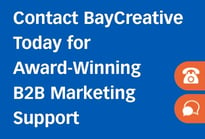Most of our B2B clients find themselves in markets that suit themselves well to good branding practices. For them, good branding represents an effective, persistent way to communicate their company's value proposition. It's also the cornerstone of their relationship with everyone from customers to prospects to business partners. By ensuring their brand is well-managed and maintained in the long term, they build familiarity and confidence — two key components in ensuring that prospective and current customers feel comfortable doing business with them.

The messaging a company uses is critical. For many companies, improvements here represent "low hanging fruit," where simple changes can produce outsize results. Why? The unfortunate fact for most companies is that their customers consider more than half of their marketing communications irrelevant. Fortunately, while each client is unique, there are a few broad steps nearly anyone can take to energize the messaging for their B2B brand and ensure they stay ahead of the curve.
1. Tailor messaging to specific buyers and audience types.
Consider the audience type. Are they customers, channel partners, or inside/ outside/channel sales? What kind of buyers are they — users, technical specialists, or executives? Every one of them wants to know the answer to the same question: What’s in it for me? Once you have a solid understanding of your buyer — their pain points and motivations — you can ensure your messaging will resonate with their perspectives and interests.
2. Identify and proactively answer pre-buying questions.
Ultimately, your messaging should answer every "inner question" prospective buyers are likely to have before they sign on the dotted line.
Each audience has fundamentally different questions. Customers may ask why they should purchase your solution instead of the competitor’s. Channel partners may want to know why they should be distributing your product or your service. Sales wants to know why they should spend time selling the product or service, and so forth. Take the time to understand what unspoken questions your audiences have — and focus your messaging on the most impactful criteria swaying their decision.
3. Target specific sales opportunities or market segments.
The jack-of-all-trades is a master of none. Any messaging that tries to address every possible market and industry tends to be so high-level it completely loses any persuasive impact. The most effective messaging is honed down to a laser-targeted set of customers, customer segments, or sales opportunities. If you target a set of customer segments, consider different ways to do this—vertically, on an industry-by-industry basis, or horizontally, across markets by department, job task, or geography, and the like.
4. Draft a messaging framework.
Conduct in-depth interviews with prospects and customers, as well as your own stakeholders, to discover the impressions people carry about your company, your competition, and the industry in general. From there, draft a messaging framework that communicates the purpose of your business, the value it brings, and its unique characters and differentiators. Include clear guidelines on how to put these to practical use to develop and maintain your brand identity. Recommended components of a messaging framework include:
- Vision statement.
- Mission statement.
- Value proposition.
- Positioning statement.
- Core promises.
- Differentiators.
- Key attributes.
- Benefit statements.
- Voice.
- Key messages/themes.
- 30-second elevator pitch.
- About Us statement.
- Tagline.
- ... and potentially other statements that will form the basis of all communications.
5. Ensure your messaging is persuasive throughout the product life cycle.
When a product category or technology is in the early phases of its life cycle, customers' most pressing questions tend to revolve around why they should abandon the status quo and shift to your newer solution. Later on in the life cycle, the questions tend to focus on why they should be buying from you instead of your competitors. This is a subtle but crucial distinction. If you ensure your messaging fits the unspoken questions of your prospects in this manner, however, you can produce dramatic increases in sales with a minimum amount of time and effort.
If you are looking for an area in your company's marketing where small, simple, and seemingly insignificant changes can translate into major increases in the bottom line — it's our experience that messaging refinements are an excellent candidate. As a rule, media costs the same regardless of the message, yet a slightly different approach to the message can produce dramatically different results. For the amount of money you spend on marketing, wouldn’t you rather have a message that delivers the maximum benefit to your organization? Start with the five steps we list here, and you will be well on your way to achieving it.
Visit the BayCreative website for more information on how we can help "energize" your brand (messaging, positioning and visual identity).

